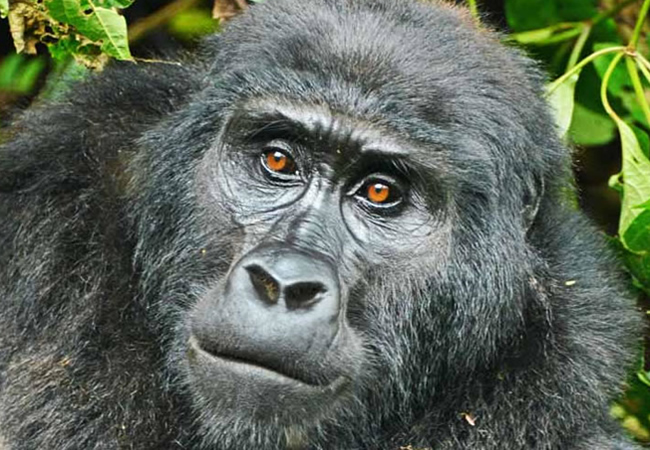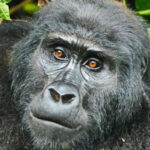Africa is a continent of remarkable diversity, teeming with life and natural beauty that never fails to astound. Among its extraordinary residents are the great apes, our closest relatives in the animal kingdom. These magnificent creatures are celebrated for their intelligence and intricate social structures, captivating the hearts and minds of wildlife enthusiasts and adventurers from around the world.
If you’re seeking unforgettable primate expeditions in Africa that will leave you in awe, the Great Apes of Africa Expedition is the perfect choice. This exciting journey will take you deep into the pristine rain forests of Uganda and Rwanda, where you’ll have the unique opportunity to come face-to-face with these African great apes in their natural habitats.
The Eastern Gorillas
Eastern gorillas are a critically endangered great ape species found in the heart of Africa’s forests. Eastern gorillas can be divided into two subspecies the eastern lowland gorilla and the mountain gorilla. The eastern lowland gorilla is also called Grauer’s gorilla, especially among scientists.
Eastern lowland gorillas, or Grauer’s gorillas, are only found in the main tropical rain forest of the Democratic Republic of Congo. Here, they’re found in Kahuzi-Biega and Maiko National Park, though much of their range encompasses unprotected forest areas.
As their name would suggest, mountain gorillas live in the mountains. The mountain gorilla subspecies is restricted to two separate areas of Afromontane Forest the Bwindi Impenetrable National Park in southwestern Uganda and Virunga Massif, a volcanic mountain range spanning the Democratic Republic of Congo, Rwanda, and Uganda.
Gorillas are one of humans’ closest genetic relatives, descending from a common ancestor 10 million years ago. Analysis of the gorilla genome found that gorillas share more than 96% of their genes with humans. Gorillas bear some physical and behavioral resemblance to humans. They have been observed to display various emotions, from laughing and playing to crying and grieving.
Eastern gorillas are particularly social creatures, living in groups known as troops or bands. These groups are usually led by a dominant alpha male called a silverback gorilla. Troop sizes can range from a few individuals to 30 eastern gorillas. The troops comprise the lead silverback, female gorillas, their offspring, and some younger, subordinate males. Eastern gorillas form strong social and familial bonds within their troops through grooming, play, and communication via complex vocalizations and body language.
The Western gorillas
The western lowland gorilla is one of two subspecies of the western gorilla, the other subspecies being the Cross River gorilla. Western lowland gorillas are the smallest gorillas. They are also the most widespread. They live in lush rain forests across 700,000 square kilometers in Central Africa. Male western lowland gorillas are much larger than females, reaching an average weight of 136 kilograms and an average height of 1.8 metres. Females have an average height of 1.4 metres and weigh between 68-90 kilograms.
Compared to other gorilla subspecies, they’re also lighter in color and have a face shape with a more pronounced brow ridge and smaller ears.
Western lowland gorillas are primarily herbivores, eating various rainforest vegetation, including fruits, roots, herbs, shrubs, vines, and shoots. They supplement this diet with some small insects they find on the vegetation they eat, like ants and other invertebrates, which act as an extra source of protein. A male western lowland gorilla can eat as much as 20 kilograms of food daily.
Western gorillas are social animals and live in groups of 2 to 30 individuals. Most groups have around five members, including a silverback male, potentially some younger blackback males, and several females, plus their infants. Females usually leave their birth groups once they reach sexual maturity to find a mate and join a new group. Males also leave their birth groups but typically go through a ‘bachelor’ phase while they mature enough to win a mate. During this time, they live alone or in all-male groups. The silverback leader of a group has exclusive mating rights to all females, though he can also choose to let other blackback males’ mate with them.
Gorillas spend their days and nights in nests. During the day, they find a comfortable resting spot and use foliage and branches to form a nest. Males tend to prefer the ground, while females sometimes nest in trees. At night, they also make nests for sleeping. Infants share nests with their
The Chimpanzees
Chimpanzees can be found from southern Senegal across the forested belt north of the Congo River to western Uganda and western Tanzania. They live in fission-fusion societies of up to 150 individuals, splitting up into small groups when traveling or foraging during the day and coming back together to sleep at night. There is a distinct linear dominance hierarchy in male chimpanzees, and males are dominant over females. They are generally fruit and plant eaters, but they also consume insects, eggs, and meat. Chimpanzees employ tools to gain access to food. Chimpanzees groom each other daily, and this activity has important social functions such as calming individuals and solidifying their bonds with each other.
The characteristic chimpanzee shape includes arms that extend beyond the knees, opposable thumbs, and a prominent mouth. Chimpanzees’ arms are longer than their legs. The skin on the face, ears, palms, and soles of the feet is bare, and the rest of the body is covered with coarse brown to black hair.
Infant chimpanzees have very pale brownish skin on their faces, ears, palms of their hands, and soles of their feet. Infants also have a white tail tuft that disappears by early adulthood.
Female chimpanzees reach reproductive age at 13 years of age, males at around 16 years of age. Mating occurs throughout the year and there is no evidence of a birth season, although there is seasonality in the number of estrous females in a group relating to food abundance. The gestation period is around 230 days, and chimpanzees typically give birth to a single infant.
The survival and emotional health of the young is primarily dependent on maternal care. By 4-6 years of age, chimpanzees are weaned and infancy ends. Juveniles, 6-9 years of age, remain close to their mothers, but they also have more interactions with other members of their community. The lifespan of a wild chimpanzee is 40 to 45 years.
The Bonobos
Bonobos are found only in DR Congo. They live in fission-fusion societies of up to 100 individuals, usually splitting into small groups when searching for food during the day and coming back together to sleep at night. The bonobos’ generally peaceful, egalitarian, and cooperative society is attributed to the evolution of a highly complex social system. Females’ bonobos are dominant in bonobo society, with females forming tight bonds against males through same-sex socio-sexual contact that is thought to limit aggression. Fruit makes up half of bonobos’ diet, but they also eat vegetation and occasionally supplement their diet with insects, larvae, earthworms, eggs, and small mammals.
Bonobos have black hair and black faces from birth, and pink lips, small ears, and wide nostrils. The long hair on the head looks as if it is parted and bonobos do not tend to go bald with age. Bonobos are born with a white tail tuft. The bonobo has a slim upper body, thin neck, narrow shoulders, and long legs.
Often confused with the common chimpanzee, the bonobo is generally considered to be the more gracile species, and has noticeably smaller head and ears, a flatter face, and a less prominent brow ridge. Adult bonobos retain the white tail tuft that common chimpanzees lose after infancy.
Female bonobos reach sexual maturity at approximately 12 years of age. The gestation period is 220-240 days. They normally give birth to a single young. Offspring have a black face and hands, with ears hidden behind whiskers. The young are cared for until they are 4-5 years old, and females have 5-6 offspring in their lifetime.
A male bonobo remains with his mother’s group for life, whereas females leave the maternal group for another at maturity. The lifespan of bonobos in the wild is unknown, and 40 years in captivity.
In conclusion
Encountering Africa’s great apes in their natural environments is one of life’s most extraordinary primate safari experiences in Uganda’s national parks. Get started with planning your next safari in Central Africa with one of the local tour operators listed on this website.


